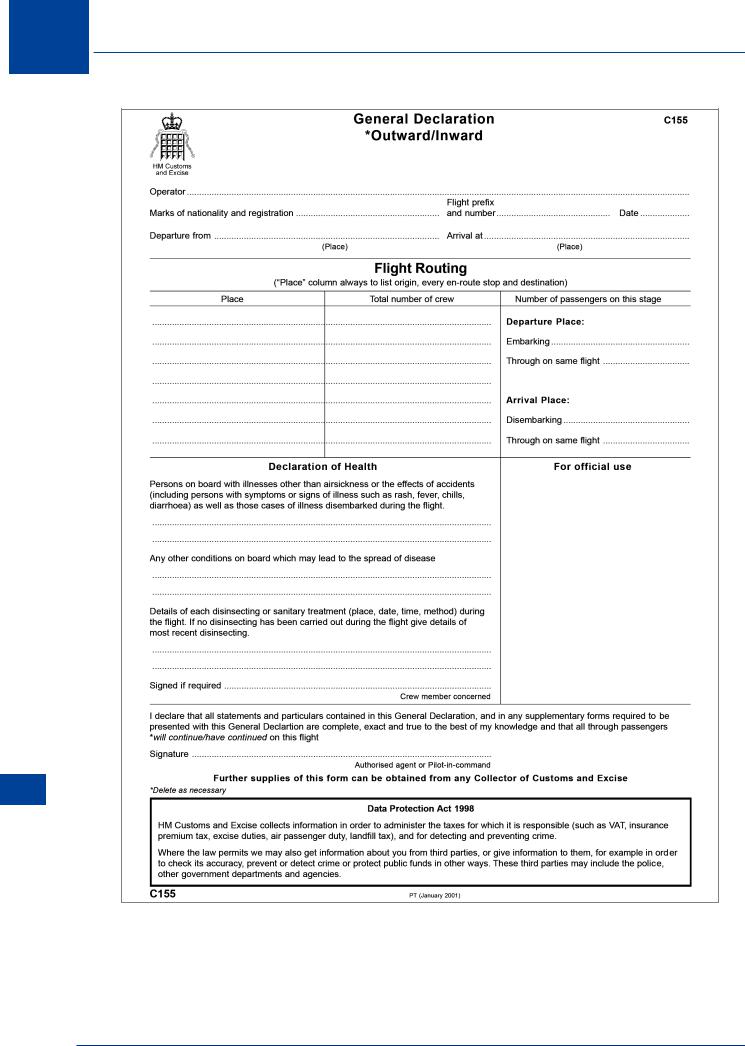
- •Textbook Series
- •Contents
- •1 Definitions
- •Introduction
- •Abbreviations
- •Definitions
- •2 International Agreements and Organizations
- •The Chicago Convention
- •International Law
- •Commercial Considerations
- •Customs and Excise, and Immigration
- •International Obligations of Contracted States
- •Duties of ICAO Member States
- •Status of Annex Components
- •The International Civil Aviation Organization (ICAO)
- •The Organization of ICAO
- •Regional Structure of ICAO
- •Regional Structure and Offices
- •ICAO Publications
- •Other International Agreements
- •The Conventions of Tokyo, the Hague and Montreal
- •The Warsaw Convention
- •The Rome Convention
- •IATA
- •ECAC
- •EASA
- •Eurocontrol
- •World Trade Organization
- •Geneva Convention
- •EU Regulation 261/2004
- •Questions
- •Answers
- •3 Airworthiness of Aircraft
- •Introduction
- •Airworthiness
- •Questions
- •Answers
- •4 Aircraft Nationality and Registration Marks
- •Introduction
- •Nationality and Registration Marks
- •Certification of Registration
- •Aircraft Markings
- •Classification of Aircraft
- •Questions
- •Answers
- •5 Flight Crew Licensing
- •Introduction
- •Definitions
- •General Rules Concerning Licensing
- •Licences and Ratings for Pilots
- •Multi-crew Pilot Licence (MPL)
- •Instrument Rating (Aeroplane) (IR(A))
- •Instructor and Examiner Rating
- •JAR-FCL 3 Medical Requirements
- •Pilot Proficiency
- •EASA Theoretical Knowledge Examinations
- •Questions
- •Answers
- •6 Rules of the Air
- •History
- •Applicability of the Rules of the Air
- •General Rules
- •Visual Flight Rules
- •Instrument Flight Rules
- •Semi-circular Flight Level Rules and RVSM
- •Special VFR
- •Distress and Urgency Signals
- •Restricted, Prohibited or Danger Areas
- •Signals for Aerodrome Traffic
- •Marshalling Signals
- •Flight Deck Signals
- •Questions
- •Answers
- •Instrument Procedures
- •PANS OPS
- •Instrument Departure Procedures
- •Questions
- •Answers
- •8 Approach Procedures
- •Procedure Basics
- •Approach Procedure Design
- •Obstacle Clearance Altitude/Height
- •Operating Minima
- •Descent Gradients
- •Track Reversal and Racetracks
- •Missed Approach Segment and Procedure
- •Published Information
- •RNAV Approach Procedures based on VOR/DME
- •Questions
- •Answers
- •9 Circling Approach
- •Circling Approach
- •Questions
- •Answers
- •10 Holding Procedures
- •Holding Procedures
- •Entry Sectors
- •ATC Considerations
- •Obstacle Clearance
- •Questions
- •Answers
- •11 Altimeter Setting Procedure
- •Altimeter Setting Objectives
- •Transition
- •Phases of Flight
- •Questions
- •Answers
- •12 Parallel or Near-parallel Runway Operation
- •Safety
- •Runway Spacing
- •Questions
- •Answers
- •13 SSR and ACAS
- •Airborne Collision Avoidance System (ACAS)
- •Questions
- •Answers
- •14 Airspace
- •Introduction
- •Control Areas and Zones
- •Classes of Airspace
- •Required Navigation Performance (RNP)
- •Airways and ATS Routes
- •Questions
- •Answers
- •15 Air Traffic Services
- •Introduction
- •Air Traffic Control
- •ATC Clearances
- •Control of Persons and Vehicles at Aerodromes
- •The Flight Information Service
- •The Alerting Service
- •Procedures
- •Questions
- •Answers
- •16 Separation
- •Concept of Separation
- •Vertical Separation
- •Horizontal Separation
- •Radar Separation
- •Procedural Wake Turbulence Separation
- •Radar Wake Turbulence Separation
- •Visual Separation in the Vicinity of Aerodromes
- •Stacking
- •Questions
- •Answers
- •17 Control of Aircraft
- •Procedural ATC
- •Radar Control
- •Radar Identification
- •Radar Service
- •Aerodrome Control
- •Approach Control Service
- •Air Traffic Advisory Service
- •Aircraft Emergencies
- •Questions
- •Answers
- •18 Aeronautical Information Service (AIS)
- •Introduction
- •General
- •The Integrated Aeronautical Information Package
- •The Aeronautical Information Publication (AIP)
- •Notices to Airmen (NOTAM)
- •SNOWTAM
- •ASHTAM
- •Aeronautical Information Circulars (AICs)
- •Pre-flight and Post-flight Information
- •Questions
- •Answers
- •Introduction
- •Aerodrome Reference Code
- •Glossary of Terms
- •Aerodrome Data
- •Runways
- •Taxiways
- •Aprons
- •Questions
- •Answers
- •Requirements
- •Visual Aids for Navigation
- •Runway Markings
- •Taxiway Markings
- •Signs
- •Markers
- •Visual Docking Guidance Systems
- •Questions
- •Answers
- •21 Aerodrome Lighting
- •Aerodrome Lights
- •Approach Lighting Systems
- •Runway Lighting
- •Taxiway Lighting
- •Questions
- •Answers
- •22 Obstacle Marking and Aerodrome Services
- •Introduction
- •Visual Aids for Denoting Obstacles
- •Visual Aids for Denoting Restricted Use Areas
- •Emergency and Other Services
- •Other Aerodrome Services
- •Questions
- •Answers
- •23 Facilitation
- •Entry and Departure of Aircraft
- •Questions
- •Answers
- •24 Search and Rescue
- •Definitions and Abbreviations
- •Establishment and Provision of SAR Service
- •Co-operation between States
- •Operating Procedures
- •Questions
- •Answers
- •25 Security
- •Introduction
- •Objectives
- •Organization
- •Preventative Security Measures
- •Management of Response to Acts of Unlawful Interference
- •Further Security Information
- •Questions
- •Answers
- •26 Aircraft Accident and Incident Investigation
- •Introduction
- •Objective of Investigation
- •Investigations
- •Serious Incidents
- •EU Considerations
- •Questions
- •Answers
- •27 Revision Questions
- •Revision Questions
- •Answers
- •EASA Specimen Examination
- •Answers to Specimen EASA Examination
- •28 Addendum – EASA Part-FCL & Part-MED
- •Chapter Five. Flight Crew Licensing
- •European Aviation Safety Agency (EASA)
- •Licences
- •Ratings
- •Certificates
- •EASA Part-MED
- •29 Index

Chapter
23
Facilitation
Aim |
|
|
|
|
453 |
Entry and Departure of Aircraft . . . . . . |
. . . . . . . . . . . . |
. . |
. . |
. |
453 |
Questions . . . . . . . . . . . . . . |
. . . . . . . . . . . . |
. . |
. . |
. |
458 |
Answers . . . . . . . . . . . . . . |
. . . . . . . . . . . . |
. . |
. . |
. . |
460 |
451

23 Facilitation
Facilitation 23
452

Facilitation 23
Aim
23.1Article 37. The Standards and Recommended Practices on Facilitation contained in Annex 9 are the outcome of Article 37 of the Convention, which provides that the “International Civil Aviation Organization shall adopt and amend from time to time, as may be necessary, international standards and recommended practices and procedures dealing with customs and immigration procedures and other matters concerned with the safety, regularity and efficiency of air navigation as may from time to time appear appropriate”. The policy with respect to the implementation by States of the Standards and Recommended Practices on Facilitation is strengthened by Article 22 of the Convention, which expresses the obligation accepted by each Contracting State “to adopt all practicable measures, through the issuance of special regulations or otherwise, to facilitate and expedite navigation by aircraft between the territories of Contracting States, and to prevent unnecessary delays to aircraft, crews, passengers, and cargo, especially in the administration of the laws relating to immigration, quarantine, customs and clearance”, and by Article 23 of the Convention, which expresses the undertaking of each Contracting State “so far as it may find practicable, to establish customs and immigration procedures affecting international air navigation in accordance with the practices which may be established or recommended from time to time pursuant to this Convention”.
23.2Documentation. The documentation required by States for the entry and departure of aircraft, crew and passengers have evolved from the same documentation required for shipping and much of the terminology has been retained. The rapid movement of aircraft and the philosophy of expediting the movement of aircraft has led to procedures where the old documents are now out of date and, where still necessary, have been replaced by electronic data systems and digital transmission systems.
Entry and Departure of Aircraft |
|
|
23.3 General. Government regulations and procedures applicable to the clearance of aircraft |
|
|
shall be no less favourable than those applied to other forms of transportation. Contracting |
|
|
States shall adopt procedures for the clearance of aircraft, including those normally applied |
|
|
for aviation security purposes, as well as those appropriate for narcotics control, which will be |
|
|
applied and carried out in such a manner as to retain the advantage of speed inherent in air |
|
|
transport. |
|
|
23.4 Documents. No documents other than those provided for in Annex 9 shall be required |
|
|
by the public authorities from operators for the entry and departure of aircraft. Where a |
|
|
Contracting State introduces electronic data interchange (EDI) techniques for a clearance |
23 |
|
function, authorities should also execute a plan for migration to complete reliance on the |
||
|
||
Facilitation |
||
traveller to enter that State without a visa (e.g. under the US visa waiver scheme) the State of |
||
electronic system for the exchange of required information with a view towards phasing |
|
|
out the requirement for preparation and exchange of paper documents. If a State permits a |
|
|
departure will not require the traveller to obtain any other document relating to the traveller’s |
|
|
identity other than the passport. |
|
|
23.5 General Declaration. A general declaration is an internationally recognized form |
|
|
which contains details of the aircraft (Registration Mark and nationality), the flight number, |
|
|
date and place of departure, and destination. It also contains details of the flight routing and |
|
|
the number of crew and passengers boarding and disembarking at the various locations. It |
|
|
contains a health declaration and a certificate signed by the PIC or an authorized agent. It is |
|
|
the eventual aim to eliminate from the general declaration, any reference to passengers. |
|
453

23 Facilitation
Facilitation 23
Figure 23.1 General declaration
454

Facilitation 23
Contracting States will not require the presentation of the General Declaration when this information can be readily obtained in an alternative and acceptable manner.
A Contracting State which continues to require the presentation of the General Declaration shall accept it when signed by either the authorized agent or the pilot-in-command, but may, when necessary, require the health section thereof to be signed by a crew member when the General Declaration itself has been signed by a non-crew member. Where Contracting States require the presentation on entry and departure of aircraft of information relating to crew members, such information shall be limited to the number of crew on board. Where the General Declaration continues to be required, this information shall be provided in the column headed “Total number of crew”.
23.6 Manifests. In addition to the General Declaration, Passenger and Cargo manifests are additional internationally recognized documents that detail names of passengers and the nature of goods and number of packages embarked on the aeroplane. When a Contracting State has eliminated the Passenger Manifest and no longer requires the General Declaration (except for purposes of attestation) it shall accept, at the option of the operator, either a General Declaration or an appropriate attestation, signed by the authorized agent or pilot-in- command, on one page only of the Cargo Manifest. The attestation on the Cargo Manifest can be provided by means of a rubber stamp. The information contained in the Cargo Manifest are details of: The Airway Bill number, the number of packages and the nature of the goods.
Figure 23.2
23.7 Passenger Baggage. Contracting States shall not require the presentation of a list of the number of pieces of accompanied baggage. Operators carrying baggage shall, upon request from the authorities, provide them with any available information where it has not otherwise been provided for customs clearance purposes by the passenger. Unaccompanied baggage may be cleared using a simplified procedure.
Facilitation 23
455

23 Facilitation
Facilitation 23
23.8Stores List. This details the goods (whether or not sold) intended for the consumption of passengers and crew as well as goods necessary for the operation and maintenance of the aircraft, including fuel and lubricants.
23.9Unaccompanied Baggage. Unaccompanied baggage is cleared under procedures applicable to cargo but in accordance with a simplified procedure.
23.10Oral Declaration. An oral (spoken) declaration is acceptable concerning the content of crew and passenger baggage. A random inspection of baggage is acceptable.
23.11Completion of Documents. Documents may be typewritten, produced in electronic data form or handwritten in ink or indelible pencil, providing it is in a legible form (block capitals).
23.12Number and type of documents required. States are not to require from Operators more than 3 copies of the General Declaration, 3 copies of the Cargo Manifest and 3 copies of the General Stores List
23.13Advanced Notification of Arrival. Where non-scheduled flights are made by an aircraft registered in an ICAO Contracting State which wishes to land in another Contracting State for non traffic purposes (2nd freedom flight), the submission of a flight plan is considered sufficient advanced notification to the State of Landing that the flight is to be conducted. However, the authority of State of Landing will accept that flight providing the flight plan is received at least two hours in advance of the arrival and that landing occurs at a previously designated international airport. Where such addressees are required to be notified (customs, immigration, police etc.) the flight plan is to be addressed to the appropriate authorities of the State concerned.
23.14Crew and Other Operators’ Personnel. Contracting States shall ensure that when inspection of crew members and their baggage is required on arrival or departure, such inspection shall be carried out as expeditiously as possible. Contracting States shall provide facilities which will enable crew members of their airlines to obtain without delay and without charge, crew members’ certificates (CMC), valid for the crew members’ term of employment.
Note: The CMC was developed as a card for use for identification purposes by both flight crew and cabin attendants, leaving the crew licences to serve their primary purpose of attesting to the professional qualifications of the flight crew.
In the case of airline flight crew and cabin attendants who retain their crew member certificates in their possession when embarking and disembarking, remain at the airport where the aircraft has stopped or within the confines of cities adjacent thereto, and depart on the same aircraft or their next regularly scheduled flight, each Contracting State shall accept a crew member certificate for temporary admission to the State and shall not require a passport or visa, (see Notes).
Note 1: It is the intent of this provision that a crew member certificate shall be recognized as a satisfactory identity document even if the holder is not a national of the State of Registry of the aircraft on which he serves. It is not desired to discourage Contracting States from issuing such crew member certificates to resident alien crew members if they are willing to do so.
Note 2: The implementation of this permits rapid and efficient disposition of personnel by airlines. The full benefit cannot be derived from these provisions while some States withhold acceptance of them.
456

Facilitation 23
23.15Non-scheduled Operations. Each Contracting State shall extend privileges of temporary admission to flight crew and cabin attendants of an aircraft operated for remuneration or hire but not engaged in scheduled international air services, subject to the requirement that such flight crew and cabin attendants must depart on the aircraft on its first flight out of the territory of the State.
23.16Transit Passengers. Passengers may remain in a transit lounge for a maximum of 2
days.
23.17Freedom from Duty. An aircraft which is not engaged in international scheduled air services and which is making a flight to or through any designated airport in a Contracting State, and is admitted temporarily free of duty, shall be allowed to remain in that State for a period of time as established by the State.
23.18Responsibility of the Operator for Custody and Care of Passengers. The responsibility of the Operator for custody and care of passengers and crew members shall terminate from the moment such persons have been admitted into that State.
Facilitation 23
457
